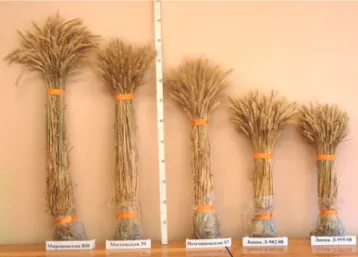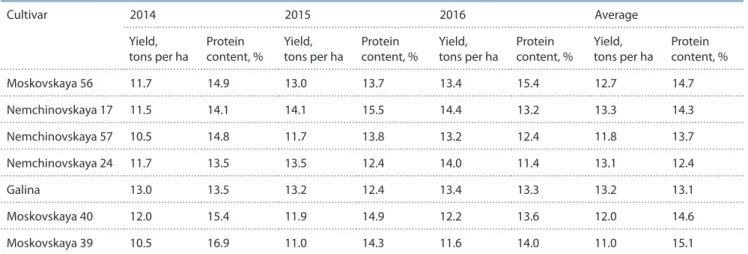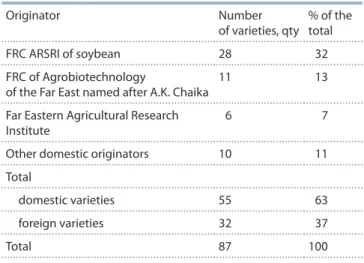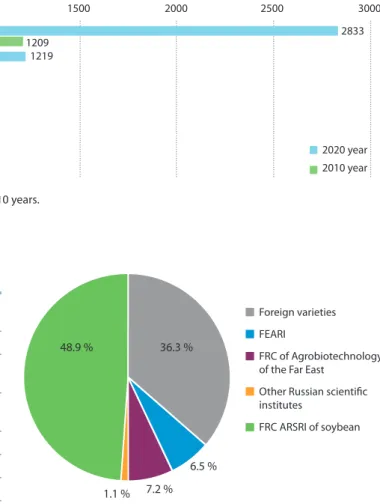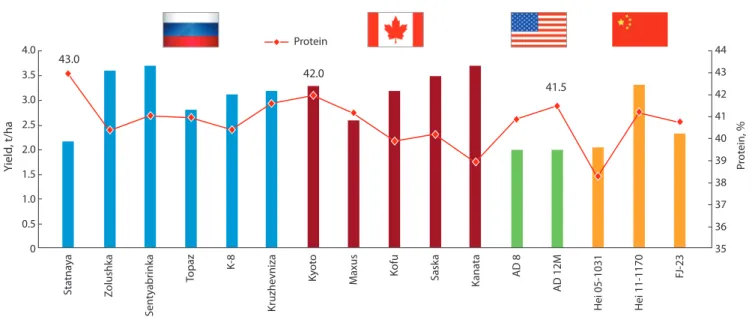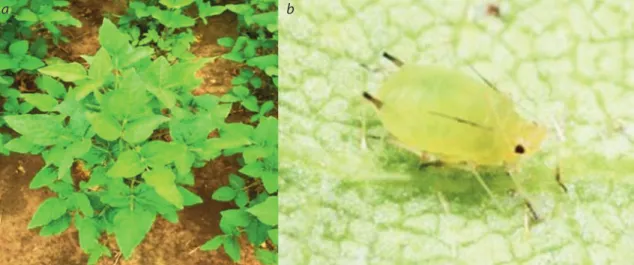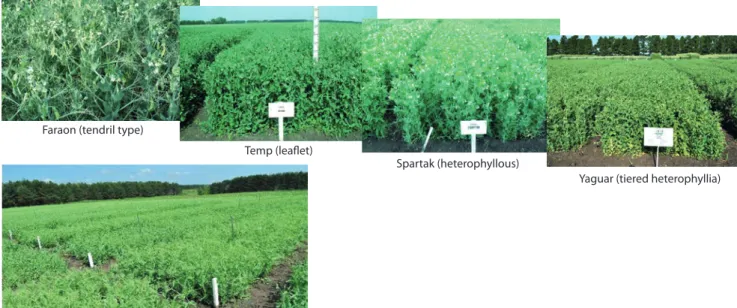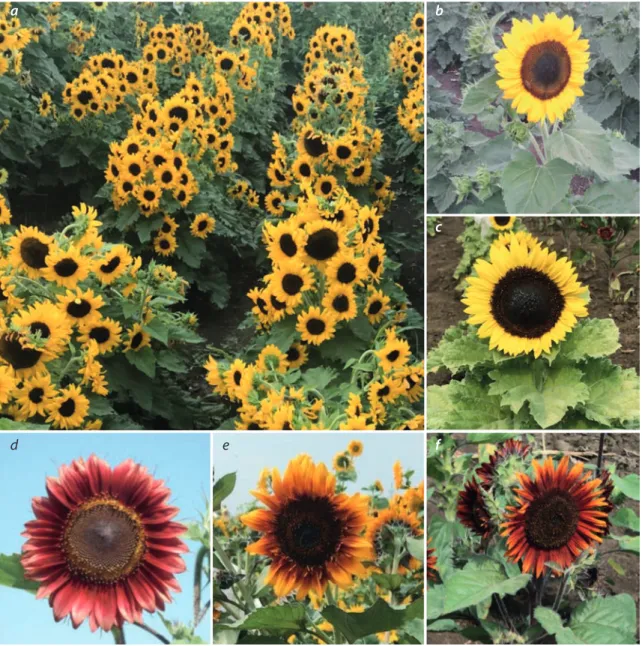ВАВИЛОВСКИЙ ЖУРНАЛ ГЕНЕТИКИ И СЕЛЕКЦИИ
Основан в 1997 г.
Периодичность 8 выпусков в год DOI 10.18699/VJ21.051
Научный рецензируемый журнал
Учредители
Сибирское отделение Российской академии наук
Федеральное государственное бюджетное научное учреждение «Федеральный исследовательский центр Институт цитологии и генетики Сибирского отделения Российской академии наук»
Межрегиональная общественная организация Вавиловское общество генетиков и селекционеров Главный редактор
В.К. Шумный – академик РАН, д-р биол. наук, профессор (Россия) Заместители главного редактора
Н.А. Колчанов – академик РАН, д-р биол. наук, профессор (Россия) И.Н. Леонова – д-р биол. наук (Россия)
Н.Б. Рубцов – д-р биол. наук, профессор (Россия) Ответственный секретарь
Г.В. Орлова – канд. биол. наук (Россия)
Редакционная коллегия
Т.Г. Амстиславская – д-р биол. наук (Россия) Е.Е. Андронов – канд. биол. наук (Россия) Ю.С. Аульченко – д-р биол. наук (Россия)
Д.А. Афонников – канд. биол. наук, доцент (Россия) Е.В. Березиков – канд. биол. наук, проф. (Нидерланды) Н.П. Бондарь – канд. биол. наук (Россия)
С.А. Боринская – д-р биол. наук (Россия) П.М. Бородин – д-р биол. наук, проф. (Россия) Т.А. Гавриленко – д-р биол. наук (Россия) В.Н. Даниленко – д-р биол. наук, проф. (Россия) С.А. Демаков – д-р биол. наук (Россия)
Е.А. Долгих – д-р биол. наук (Россия)
Ю.М. Константинов – д-р биол. наук, проф. (Россия) О. Кребс – д-р биол. наук, проф. (Германия)
И.Н. Лаврик – д-р биол. наук (Германия) Д. Ларкин – д-р биол. наук (Великобритания) И.Н. Лебедев – д-р биол. наук, проф. (Россия) Л.А. Лутова – д-р биол. наук, проф. (Россия)
В.Ю. Макеев – чл.-кор. РАН, д-р физ.-мат. наук (Россия) М.П. Мошкин – д-р биол. наук, проф. (Россия)
Л.Ю. Новикова – канд. техн. наук (Россия) Е. Песцова – д-р биол. наук (Германия) Н.А. Проворов – д-р биол. наук, проф. (Россия) Д.В. Пышный – чл.-кор. РАН, д-р хим. наук (Россия) А.В. Ратушный – канд. биол. наук (США)
М.Г. Самсонова – д-р биол. наук (Россия) Е. Туруспеков – канд. биол. наук (Казахстан)
М. Чен – д-р биол. наук (Китайская Народная Республика) Ю. Шавруков – д-р биол. наук (Австралия)
Редакционный совет
Л.И. Афтанас – академик РАН, д-р мед. наук (Россия) В.С. Баранов – чл.-кор. РАН, д-р мед. наук (Россия) Л.А. Беспалова – академик РАН, д-р с.-х. наук (Россия) А. Бёрнер – д-р наук (Германия)
М.И. Воевода – академик РАН, д-р мед. наук (Россия) И. Гроссе – д-р наук, проф. (Германия)
Г.Л. Дианов – д-р биол. наук, проф. (Великобритания) Ю.Е. Дуброва – д-р биол. наук, проф. (Великобритания) Н.Н. Дыгало – чл.-кор. РАН, д-р биол. наук (Россия) И.К. Захаров – д-р биол. наук, проф. (Россия)
И.А. Захаров-Гезехус – чл.-кор. РАН, д-р биол. наук (Россия) С.Г. Инге-Вечтомов – академик РАН, д-р биол. наук (Россия) И.Е. Керкис – д-р наук (Бразилия)
А.В. Кильчевский – чл.-кор. НАНБ, д-р биол. наук (Беларусь) С.В. Костров – чл.-кор. РАН, д-р хим. наук (Россия)
А.В. Кочетов – чл.-кор. РАН, д-р биол. наук (Россия) Ж. Ле Гуи – д-р наук (Франция)
Б. Люгтенберг – д-р наук, проф. (Нидерланды) В.И. Молодин – академик РАН, д-р ист. наук (Россия) В.П. Пузырев – академик РАН, д-р мед. наук (Россия) А.Ю. Ржецкий – канд. биол. наук, проф. (США) И.Б. Рогозин – канд. биол. наук (США)
А.О. Рувинский – д-р биол. наук, проф. (Австралия) Е.А. Салина – д-р биол. наук, проф. (Россия) К.В. Славин – д-р наук, проф. (США)
В.А. Степанов – чл.-кор. РАН, д-р биол. наук (Россия) И.А. Тихонович – академик РАН, д-р биол. наук (Россия) Е.К. Хлесткина – д-р биол. наук, профессор (Россия) Л.В. Хотылева – академик НАНБ, д-р биол. наук (Беларусь) Э.К. Хуснутдинова – д-р биол. наук, проф. (Россия) М.Ф. Чернов – д-р мед. наук (Япония)
С.В. Шестаков – академик РАН, д-р биол. наук (Россия) Н.К. Янковский – академик РАН, д-р биол. наук (Россия)
VAVILOV JOURNAL
OF GENETICS AND BREEDING
Founded in 1997
Published 8 times annually
Founders
Siberian Branch of the Russian Academy of Sciences
Federal Research Center Institute of Cytology and Genetics of the Siberian Branch of the Russian Academy of Sciences The Vavilov Society of Geneticists and Breeders
Editor-in-Chief
V.K. Shumny, Full Member of the Russian Academy of Sciences, Dr. Sci. (Biology), Russia Deputy Editor-in-Chief
N.A. Kolchanov, Full Member of the Russian Academy of Sciences, Dr. Sci. (Biology), Russia I.N. Leonova, Dr. Sci. (Biology), Russia
N.B. Rubtsov, Professor, Dr. Sci. (Biology), Russia Executive Secretary
G.V. Orlova, Cand. Sci. (Biology), Russia Editorial council
L.I. Aftanas, Full Member of the RAS, Dr. Sci. (Medicine), Russia V.S. Baranov, Corr. Member of the RAS, Dr. Sci. (Medicine), Russia L.A. Bespalova, Full Member of the RAS, Dr. Sci. (Agricul.), Russia A. Börner, Dr. Sci., Germany
M.F. Chernov, Dr. Sci. (Medicine), Japan
G.L. Dianov, Professor, Dr. Sci. (Biology), Great Britain Yu.E. Dubrova, Professor, Dr. Sci. (Biology), Great Britain N.N. Dygalo, Corr. Member of the RAS, Dr. Sci. (Biology), Russia J. Le Gouis, Dr. Sci., France
I. Grosse, Professor, Dr. Sci., Germany
S.G. Inge-Vechtomov, Full Member of the RAS, Dr. Sci. (Biology), Russia I.E. Kerkis, Dr. Sci., Brazil
E.K. Khlestkina, Professor, Dr. Sci. (Biology), Russia
L.V. Khotyleva, Full Member of the NAS of Belarus, Dr. Sci. (Biology), Belarus E.K. Khusnutdinova, Professor, Dr. Sci. (Biology), Russia
A.V. Kilchevsky, Corr. Member of the NAS of Belarus, Dr. Sci. (Biology), Belarus A.V. Kochetov, Corr. Member of the RAS, Dr. Sci. (Biology), Russia
S.V. Kostrov, Corr. Member of the RAS, Dr. Sci. (Chemistry), Russia B. Lugtenberg, Professor, Dr. Sci., Netherlands
V.I. Molodin, Full Member of the RAS, Dr. Sci. (History), Russia V.P. Puzyrev, Full Member of the RAS, Dr. Sci. (Medicine), Russia I.B. Rogozin, Cand. Sci. (Biology), United States
A.O. Ruvinsky, Professor, Dr. Sci. (Biology), Australia A.Yu. Rzhetsky, Professor, Cand. Sci. (Biology), United States E.A. Salina, Professor, Dr. Sci. (Biology), Russia
S.V. Shestakov, Full Member of the RAS, Dr. Sci. (Biology), Russia K.V. Slavin, Professor, Dr. Sci., United States
V.A. Stepanov, Corr. Member of the RAS, Dr. Sci. (Biology), Russia I.A. Tikhonovich, Full Member of the RAS, Dr. Sci. (Biology), Russia M.I. Voevoda, Full Member of the RAS, Dr. Sci. (Medicine), Russia N.K. Yankovsky, Full Member of the RAS, Dr. Sci. (Biology), Russia I.K. Zakharov, Professor, Dr. Sci. (Biology), Russia
I.A. Zakharov-Gezekhus, Corr. Member of the RAS, Dr. Sci. (Biology), Russia
VAV I L O V S K I I Z H U R N A L G E N E T I K I I S E L E K T S I I
Editorial board
D.A. Afonnikov, Associate Professor, Cand. Sci. (Biology), Russia
T.G. Amstislavskaya, Dr. Sci. (Biology), Russia E.E. Andronov, Cand. Sci. (Biology), Russia Yu.S. Aulchenko, Dr. Sci. (Biology), Russia
E.V. Berezikov, Professor, Cand. Sci. (Biology), Netherlands N.P. Bondar, Cand. Sci. (Biology), Russia
S.A. Borinskaya, Dr. Sci. (Biology), Russia P.M. Borodin, Professor, Dr. Sci. (Biology), Russia M. Chen, Dr. Sci. (Biology), People’s Republic of China V.N. Danilenko, Professor, Dr. Sci. (Biology), Russia S.A. Demakov, Dr. Sci. (Biology), Russia
E.A. Dolgikh, Dr. Sci. (Biology), Russia T.A. Gavrilenko, Dr. Sci. (Biology), Russia
Yu.M. Konstantinov, Professor, Dr. Sci. (Biology), Russia O. Krebs, Professor, Dr. Sci. (Biology), Germany D. Larkin, Dr. Sci. (Biology), Great Britain I.N. Lavrik, Dr. Sci. (Biology), Germany
I.N. Lebedev, Professor, Dr. Sci. (Biology), Russia L.A. Lutova, Professor, Dr. Sci. (Biology), Russia V.Yu. Makeev, Corr. Member of the RAS, Dr. Sci. (Physics and Mathem.), Russiа
M.P. Moshkin, Professor, Dr. Sci. (Biology), Russia E. Pestsova, Dr. Sci. (Biology), Germany
L.Yu. Novikova, Cand. Sci. (Engineering), Russia N.A. Provorov, Professor, Dr. Sci. (Biology), Russia
D.V. Pyshnyi, Corr. Member of the RAS, Dr. Sci. (Chemistry), Russia
A.V. Ratushny, Cand. Sci. (Biology), United States M.G. Samsonova, Dr. Sci. (Biology), Russia Y. Shavrukov, Dr. Sci. (Biology), Australia E. Turuspekov, Cand. Sci. (Biology), Kazakhstan DOI 10.18699/VJ21.051
Селекция зерновых и зернобобовых культур
Селекция масличных и сахароносов
Селекция кормовых культур
Селекция винограда, ягодных,
субтропических и цветочных культур
Селекция лекарственных, эфирномасличных и овощных
Научное обеспечение селекции и семеноводства в регионах
ОБЗОР
Научная селекция озимой мягкой пшеницы в Нечерноземной зоне России:
история, методы и результаты.
Б.И. Сандухадзе, Р.З. Мамедов, М.С. Крахмалёва, В.В. Бугрова
ОБЗОР
Научное обеспечение эффективного развития селекции и семеноводства сои на Дальнем Востоке. В.Т. Синеговская
ОБЗОР
Современная селекция зернобобовых и крупяных культур в России.
В.И. Зотиков, С.Д. Вилюнов
ОБЗОР
Современные тренды селекционно- генетического улучшения сортов и гибридов подсолнечника во ВНИИМК.
В.М. Лукомец, М.В. Трунова, Я.Н. Демурин
ОРИГИНАЛЬНОЕ ИССЛЕДОВАНИЕ
Современные аспекты селекции
гибридов сахарной свеклы (Beta vulgaris L.).
С.Д. Каракотов, И.В. Апасов, А.А. Налбандян, Е.Н. Васильченко, Т.П. Федулова
ОБЗОР
Развитие современной селекции и семеноводства кормовых культур в России. В.М. Косолапов, В.И. Чернявских, С.И. Костенко
ОБЗОР
Научное обеспечение селекции и семеноводства Сибири в XXI в.
Н.П. Гончаров
ОБЗОР
Селекция винограда – ключевое звено в развитии виноградо-винодельческой отрасли. Е.А. Егоров
ОБЗОР
Научное обеспечение ягодоводства России и перспективы его развития.
И.М. Куликов, С.Н. Евдокименко, Т.А. Тумаева, А.В. Келина, Ф.Ф. Сазонов, Н.В. Андронова, М.А. Подгаецкий
ОРИГИНАЛЬНОЕ ИССЛЕДОВАНИЕ
Селекция субтропических и цветочных культур в ФИЦ «Субтропический научный центр РАН». А.В. Рындин, Р.В. Кулян, Н.А. Слепченко
ОБЗОР
Селекция лекарственных и ароматических растений в ВИЛАР: достижения
и перспективы. И.Н. Коротких, Д.Н. Балеев, А.И. Морозов, П.Г. Мизина, Н.И. Сидельников
ОБЗОР
Генетические ресурсы овощных растений:
от селекции нетрадиционных культур к функциональным продуктам питания.
Ю.В. Фотев, А.М. Артемьева, О.А. Зверева
© Сибирское отделение Российской академии наук, 2021
367
388
401
408
433 414
442 420
448 374
394 381
ОТ РЕДАКТОРА
Селекция растений – основа
продовольственной безопасности России.
Н.П. Гончаров, В.М. Косолапов
361
Breeding of cereals and grain legumes
Breeding of oil and sugar crops
Breeding of fodder crops
Breeding of grape and small-fruit, subtropical, and flower crops
Breeding of medicinal herbs, essential oil crops, and vegetables
Regional scientif ic support of breeding and seed production
367
388
401
408
433 414
442 420
448 374
394 381
REVIEW
Scientif ic breeding of winter bread wheat in the Non-Сhernozem zone of Russia:
the history, methods and results.
B.I. Sandukhadze, R.Z. Mamedov, M.S. Krakhmalyova, V.V. Bugrova
REVIEW
Scientific provision of an effective development of soybean breeding
and seed production in the Russian Far East.
V.T. Sinegovskaya
REVIEW
Present-day breeding of legumes
and groat crops in Russia. V.I. Zotikov, S.D. Vilyunov
REVIEW
Modern trends in breeding and genetic improvement of sunf lower varieties and hybrids at VNIIMK. V.M. Lukomets, M.V. Trunovа, Ya.N. Demurin
ORIGINAL ARTICLE
Modern issues of sugar beet (Beta vulgaris L.) hybrid breeding. S.D. Karakotov, I.V. Apasov,
A.A. Nalbandyan, E.N. Vasilchenko, T.P. Fedulova
REVIEW
Fundamentals for forage crop breeding and seed production in Russia.
V.M. Kosolapov, V.I. Cherniavskih, S.I. Kostenko
REVIEW
Scientific support to plant breeding and seed production in Siberia in the XXI century. N.P. Goncharov
REVIEW
Grape breeding is a key link in the development of the grapes and wine-making industry. E.A. Egorov
REVIEW
Scientif ic support of small fruit growing in Russia and prospects for its development.
I.M. Kulikov, S.N. Evdokimenko, T.A. Tumaeva, A.V. Kelina, F.F. Sazonov, N.V. Andronova, M.A. Podgaetsky
ORIGINAL ARTICLE
Subtropical and f lower crops breeding at the Subtropical Scientif ic Centre.
A.V. Ryndin, R.V. Kulyan, N.A. Slepchenko
REVIEW
Breeding of medicinal and essential oil crops in VILAR: achievements and prospects. I.N. Korotkikh, D.N. Baleev, A.I. Morozov, P.G. Mizina, N.I. Sidelnikov
REVIEW
Genetic resources of vegetable crops:
from breeding non-traditional crops to functional food. Yu.V. Fotev, A.M. Artemyeva, O.A. Zvereva
© Siberian Branch RAS, 2021
© Institute of Cytology and Genetics, SB RAS, 2021
FROM THE EDITOR
Plant breeding is the food security basis in the Russian Federation.
N.P. Goncharov, V.M. Kosolapov
361
Plant breeding is the food security basis in the Russian Federation
N.P. Goncharov1, V.M. Kosolapov2
1 Institute of Cytology and Genetics of the Siberian Branch of the Russian Academy of Sciences, Novosibirsk, Russia 2 Federal Williams Research Center of Forage Production and Agroecology, Lobnya, Moscow region, Russia
gonch@bionet.nsc.ru; vnii.kormov@yandex.ru
T
his issue of the Vavilov Journal of Genetics and Breed-ing is composed of reports of top Russian breeders de- livered at the scientific session of the RAS Department of Agricultural Sciences “Scientific support of the efficient development of crop breeding and seed production in the Russian Federation” held in Moscow on December 7, 2020.
This topic was chosen deliberately, as the food security con- cept in the Russian Federation determines the key directions and features of the modern development of Russian breeding.
They involve the understanding and comprehensive analysis of breeding trends and the determination of prospects, par- ticularly, in connection with import substitution1 and produce of next-generation cultivars.
The issue starts with the article by B.I. Sandukhadze et al. “Scientific breeding of winter bread wheat in the Non- Сhernozem zone of Russia: the history, methods and results”.
It reviews the main steps and achievements of winter common (bred) wheat (Triticum aestivum L.) in the region throughout one century of scientific breeding. It shows that breeders’
efforts increased the yield of wheat cultivars to 14.0 t/ha, which is nearly ten times as high as in cultivars of early steps of scientific breeding in the central Non-Chernozem Area.
Few residents of Moscow and Moscow region are aware of the “white spot” issue (a lot of rye was grown in the region in the early 20th century, as wheat production did not pay), suc- cessfully solved by prominent Russian breeder V.E. Pisarev by using early maturity cultivars from East Siberia. By now, cul- tivars produced by breeders of the FSC “Nemchinovka” have ensured the provision of the Non-Chernozem Area, a densely populated region of Russia, with locally produced food wheat grain and got the local population used to eating white bread.
The Russian Federation is self-sufficient in producing not only wheat, barley, or oats but also rice (Gospadinova et al., 2016).
Area under grain legumes is second to cereals in Russia.
They have accompanied cereals since the earliest steps of do- mestication on fields of ancient agriculturists. They diversified human diet and supplied domestic animals with high-protein fodder. The breeding of grain legumes is reviewed by V.T. Si- negovskaya “Scientific provision of an effective development of soybean breeding and seed production in the Russian Far East” and by V.I. Zotikov, S.D. Vilyunov “Present-day breeding of legumes and groat crops in Russia”. They note that soybean is becoming a crop of strategic importance for
1 By import substitution we mean the substitution of imported goods and services for domestic ones. It implies the slowdown in the share of foreign manufacturers in the market and timely satisfaction of demand with domestic products.
Russia and that groat crops constantly rank high in the diet of its inhabitants.
The article by V.M. Lukomets et al. “Modern trends in breeding and genetic improvement of sunflower varieties and hybrids at VNIIMK” is dedicated to the breeding of the main oil plant in the Russian Federation. The Pustovoit All- Russian Research Institute of Oil Crops (VNIIMK), along with the Yuriev Plant Production Institute (Kharkiv, Ukraine) (Kirichenko et al., 2014) excels in the breeding of sunflower and other oil crops in the former Soviet Union.
The breeding of sugar beet, the main source of sugar in Europe, is considered by S.D. Karakotov et al. “Modern issues of sugar beet (Beta vulgaris L.) hybrid breeding”. The paper presents the results of monogerm varieties and successful ap- plication of molecular methods for testing the bred material of sugar beet.
The imbalance in fodder production that has existed in Rus- sia for many years remains unresolved despite all the efforts of plant breeders. Even the considerable reduction in livestock in agricultural companies (agrofirms) and redistribution of large volumes of animal husbandry to private subsidiary farms (up to 50 % on the average) had no effect (Semenov, 2012). The article by V.M. Kosolapov et al. “Fundamentals for forage crop breeding and seed production in Russia” is dedicated just to this burning problem and potential ways to solve it.
A series of three papers is dedicated to the breeding of fruit and small fruit crops, essential for balanced nutrition.
It includes articles by E.A. Egorov “Grape breeding is a key link in the development of the grapes and wine-making in- dustry”, I.M. Kulikov et al. “Scientific support of small fruit growing in Russia and prospects for its development”, and A.V. Ryndin et al. “Subtropical and flower crops breeding at the Subtropical Scientific Centre”. At present, import substi- tution draws attention to new (or, rather, well overlooked old) natural sources of vitamins and biologically active substances and to the breeding of domestic subtropical and flower plants.
The progress in the breeding of medicinal and essential oil plants in Russia is considered by I.N. Korotkikh et al.
“Breeding of medicinal and essential oil crops in VILAR:
achievements and prospects”. This field became particularly important with regard to the sanctions, the ensuing shortage of herbal medicinal materials, and their poor quality, failing to meet the requirements of the present-day pharmaceutical industry.
Russian seed growers do not provide sufficient volumes of production of seeds of vegetable crops’ domestic varieties
(Soldatenko et al., 2020). Modern breeding is based mainly on the gene pool at hand to involve older high-yielding varieties into breeding and improve them. The article by Yu.V. Fotev et al. “Genetic resources of vegetable crops: from breeding non- traditional crops to functional food” follows traditional VIR themes. It considers the introduction of untraditional crops in Russia in the context of the greatly requested area: their use in functional nutrition (Fotev et al., 2018).
The issue is concluded by N.P. Goncharov’s review “Scien- tific support to plant breeding and seed production in Siberia in the XXI century”. It emphasizes the importance of breed- ing activity in the development of Russian economy and the necessity for the preservation of still existing research institu- tions and units of abolished Breeding Centers in Siberia. In the contrary case, the consistency of breeding works in the region will disappear, and the unique breeding material created by generations of Russian scientists in research and breeding institutions will be lost beyond retrieval. The following prob- lems are especially acute: Why cannot the federal and regional governments protect their intellectual property and preserve biodiversity of cultivated plants? What and who hampers?
These issues, typical of Siberia, as well as the availability of skilled staffing concern other regions of Russia, too.
Several articles in the issue mention the necessity of the immediate solution of urgent tasks concerning the training of breeders in higher schools as a major component of food security in Russia. Nothing changes for centuries. In the end of the 19th century, A.S. Ermolov (1891) incriminated the backwardness of Russian agriculture to the absence of an agricultural education system and to the shocking ignorance of science among peasants.
It is pertinent to make a point about the publication policy of the Ministry of Education and Science and Presidium of the Russian Academy of Sciences. It is a sore point for not only agrarians but also the entire Russian academic commu- nity. For an unknown reason, the governmental strategy of import substitution does not apply to the scientific publishing activities. The principal journal “Selektsiya i Semenovodstvo”
(Breeding and Seed Production) has ceased to be published.
Specialized agricultural journals on particular crops or groups of crops demand a nation-specific policy. A.N. Engelhardt (1987) wrote that the agricultural science in its broad sense has pronounced “national” features: “There is no Russian, English, or German chemistry; there is only one chemistry for the entire world; but agronomy may be Russian, or English, or German, or else. <…> We should create Russian agricultural science of our own, and it can be created only by combined efforts of scientists and practicians, and there should be academically trained practi- cians in between” (p. 190).
It was repeatedly noted that different branches of Rus- sian science need their own national platforms (journals) for communication and effective exchange of information. In particular, A.V. Yurevich and I.P. Tsapenko (2013) state that most Russian papers on socio-humanistic sciences are unfit for international journals not because of their flaws but because of the national specificity of their content. However, to bring studies in line with the themes of international journals means
to detach them from urgent Russian problems and to make the society think that the money of Russian taxpayers is spent in vain. Hence, the more patriotic is this or that branch of sci- ence and the more is it directed to the solution of domestic tasks, the less it fits into the international context. Even by the example of highly employable Vavilov’s studies we see that most of them are beyond the scope of interests of our Western colleagues, although they are conceptually important for the present-day global science. Neither Ministry of Education &
Science, nor the current Presidium of the RAS see room for Russian journals in the world academic community. However sad it be, the task of any import substitution seems costly to Russian officials; therefore, the publication policy is the worst weakness of Russian science. We expressly indicate that the intellectual property of Russian scientists or Russia is not protected in publications in top Western journals, and it is often unaccessible for the scientific community in this country (Gorbunov-Posadov, 2020).
For many years, breeding in Russia has been distinguished by the widespread use of genetic knowledge. Breeding and ge- netics schools are held in Siberia on a regular basis since 1976 (Zilke, 2005). We can also mention the All-Siberia program
‘Diallel Analysis’ (Dragavtsev et al., 1984). Unfortunately, the gap between breeding and modern molecular biology is still unplugged.
Academician I.I. Artobolevskiy (1967) believed on reason- able grounds that the promotion of scientific achievements is a first-order duty of scientists. We try to find out why leading breeding schools in Russia insufficiently and reluctantly em- ploy recent discoveries in molecular biology, biotechnology, and IT technologies. Presently, significant breeding achieve- ments reached by using molecular methods exist in Russia (Bespalova et al., 2012; Pershina et al., 2020; among others).
Promising studies opening up fresh opportunities for breeding are being conducted. In particular, the Institute of Cytology and Genetics (Novosibirsk) took part in the assembly of the wheat genome (IWGSC…, 2018). Here we are at the very beginning, since the information on the genome sequence from one accession is not sufficient to capture the whole spectrum of diversity in a gene pool responsible for phenotypic variation, plasticity, and environmental adaption. The de novo construc- tion of a pan-genomes for cultivated plants is a mandatory step after the establishment of reference genome sequences for them. Obviously, it will be the key step in future breed- ing (Pronozin et al., 2021). The low sequencing depths even for wheat, a staple crop in Russia, still limit the broad use of pan-genomic analysis (Rasheed, Xia, 2019).
Several important problems concerning IT technologies in breeding were discussed in the previous issue of the Vavilov Journal of Genetics and Breeding, No. 1, 2021; so, we will not touch upon them. Nevertheless, the technological gap between the performance of genomic analysis and pheno- typical description of plants is still large. In breeding a new variety, one should rest upon today’s perspectives and take into consideration both current requirements and remote prospects. Certainly, recent technological achievements in crop genomics generate new opportunities in the detection of
genetic variations of traits important for breeding and permit one to create new-generation varieties. They come to the aid of breeders and allow fast, exact, and mass-scale description of plant phenotypes be it in the field or under laboratory con- ditions.
Functional genomics is a key to molecular breeding and basement for the development of diagnostic markers for gene introgression and molecular marker-assisted selection.
Although the cloning of functional genes in crops was a slow process, few genes were cloned by conventional “positional cloning”. On the other hand, high-throughput PCR-based KASP (Kompetitive Allele-Specific PCR) markers (Rasheed et al., 2016) are helpful in the use of SNP arrays for high-density genotyping of wheat (Wang et al., 2014; Allen et al., 2017; Cui et al., 2017) and related species (Winfield et al., 2016), as well as in the annotation and introduction of functional genes. It is evident, though, that the role of money in the application of these methods to ordinary breeding is not the least, and they will not become widespread, inexpensive, and routine before long (Rasheed, Xia, 2019).
A characteristic feature of modern economy, including agri- culture, is the predominance of novelties as a factor supporting competitiveness and economic advance in the long run. The question whether molecular biology can serve as a pioneering factor in plant breeding is open. Presently, prebreeding (as- sessment of the starting breeding material) is an application domain of up-to-date molecular methods. However, it is dif- ferently viewed by molecular biologists (Rasheed et al., 2016;
Riaz et al., 2018), geneticists (Goncharov N.P. et al., 2020), and breeders (Bespalova et al., 2012). In contrast, their views on breeding itself (analysis of breeding material and selection process) are similar. Molecular methods are currently used to accelerate selection in the stabilization of breeding material (Adonina et al., 2021), its homozygotization (Pershina et al., 2020), and so on. The raise of promising breeding material can be accelerated by removing the germplasm of wild spe- cies from the progeny of introgression hybrids (Leonova et al., 2020); thereby, fragments of alien genetic material can be reduced in the genome of a species to breed (Adonina et al., 2021). This process is aimed at the reduction of adverse effects of concomitant genetic material transferred with the target genes. It has been demonstrated that molecular markers allow efficient selection for dwarfism (Kroupin et al., 2020;
Su khikh et al., 2021; etc.), early ripening (Kroupin et al., 2020), and many other traits. Meanwhile, the breeding for such important traits as crop productivity and quality of production is still conducted by conventional methods.
The assessment of the efficiency of plant genome editing by CRISPR/Cas technologies, operating with single functional genes, presents an acute and complicated problem (Chen et al., 2021). We do not know whether this one-gene manipula- tion is a breakthrough technology in breeding, which deals with hundreds of functional genes. Generally, there are no single genes whose replacement would result in sustainable progress. In addition, the CRISPR-edited plants have high somaclonal variability. Nevertheless, the tools and methods for plant transformation clearly alter phenotypes, being able
to benefit from gene overexpression and other manipulations formerly inaccessible for breeders (Borisjuk et al., 2019).
Serious progress based on advanced technologies occurs in large seed producing companies, where breeders, geneti- cists, and molecular biologists work under the same roof. For instance, DuPond-Pioneer developed the Seed Production Technology concept, which successfully combines conven- tional hybridization with transgenic methods of raising male- sterile (MS) lines, hybrid selection, and MS line support (Wu et al., 2016). The producing of nuclear MS lines by genome editing illustrates the applicability of this concept to wheat (Okada et al., 2019). Several more breakthrough technologies for hybrid creation are reviewed by Chen et al. (2021). The question remains open how soon this approach will become routine for breeding institutions.
Breeders’ work was scrutinized repeatedly. Nevertheless, we do not know how profoundly paradigm shifts in breeding (see the Figure) affect the speed of the breeding process and achievement of goals. It is doubtless that in recent decades traditional schemes involving hybridization and, to a much lesser extent, chemical and radiational mutagenesis contri- buted much to crop improvement. However, the globaliza- tion epoch necessitates the search for new groundbreaking methods. Many seemingly revolutionary methods came and went from the scientists’ toolkit and left an imprint only in breeding history records. Old-timers remember monosomic lines, which allowed the produce of varieties using the method of limited recombination and rapidly “repair” unique varieties.
To tell the truth, the development of each from monosomic lines took 15–20 years. During this time, conventional breed- ers replaced the entire range several times and produced new remarkable varieties. It is natural that this approach did not provide a single commercial variety despite the huge scope of work (Worland, 1988). Protoplasts (Gleba, Sytnik, 1984),
Milestones: the emergence of breakthrough technologies in plant breeding (after Kolchanov et al., 2017).
Breeding and genetic technologies Domestication Folk breeding…
> 10,000 yr BC
~ 1850
1964
1983 2010 Combinational
breeding
Dihaploids
Marker-assisted selection Genomic breeding
isoenzymes, and many others, looking modern in their days, did not change the breeding paradigm. It is worth mention- ing that some breakthrough projects, such as domestication or green revolution (improvement of the range of wheat and rice varieties) were implemented by conventional breeding, and they were based on the choice of key traits regardless of the genetic and/or molecular mechanisms of their inheritance.
One of the targets of modern technologies is the acceleration of new variety breeding and introduction. For some reason, the powerful take it to mean the shortening of their produc- ing time and make it the corner stone. It is a fringe concern, because the terms of variety submission to the Plant State Tasting System are insignificant in major breeding institutions, which produce series of new varieties massive. Present-day molecular Stakhanovites are nothing new. It is pertinent to recall the anecdote about the producing of cv. Lutescens 1163 common wheat by T.D. Lysenko et al. (1935) within 2.5 years by using know how: greenhouses and hybrids at hand instead of original accessions. It is sad that Stakhanovite methods of breeding are becoming nationwide again in the 21st century.
N.I. Vavilov likened a geneticist to a creator and stated that he “must act as an engineer; not only is he obliged to investigate his construction material, but he can and should construct new living species” 2. The tasks are basically the same at present, it is the toolkit that has changed and expanded.
It is well known that genetics and breeding deal with he- redity and variability and thus they interpenetrate. Breeding employs the laws of inheritance discovered by genetics, and genetics, in turn, obtains and generalizes data from breeding (Goncharov N.P., Goncharov P.L., 2018). While geneticists were seeking ways to overcome the abyss between genetics and breeding (Dragavtsev, 2005), molecular biology just revoked many of these problems (Moose, Mumm, 2008;
Heffner et al., 2009; Abd-Elsalam, Lim, 2018; Ahmar et al., 2020). We have already mentioned that breeding received new tools. They provoked controversy as to whether they should be used extensively. Certainly, to know and master them is a must. However, business has an increasing share in the science of the 21st century. To conduct a modern study is a business operation. To obtain results is a business operation.
To publish them in top-rated journals is a business operation.
In the last case, to make a successful (in the eye of the Minis- try of Education and Science) publication one should employ up-to-date expensive equipment, not necessary for the work itself. The organization of the breeding process is a business as well, since the development of crop production is increas- ingly considered only as the delivery of agricultural services.
This situation reminds the notorious “arms race”, and we can win it by promoting our own rules.
The applied aspect of Russian science progressively in- creases (Rakin, 2020). Breeding in many European coun- tries, including former COMECON members, is becoming private business under the pressure of multinational groups of agrochemical companies. The consequences are the list of top-priority research fields, the mainstream innovational practice of support by the Russian Science Foundation, the
2 Vechernyaya Moskva. Jan. 17, 1929.
technological orientation of sections of the national Nauka project, and such. The national foundations of the Russian Federation do not imply considerable support of academic studies in breeding, solely the mastering and preservation of skills and technologies. Therefore, the search for alternative large sources of support for agricultural sciences, including 21st century breeding, is of paramount importance.
To conclude, we mention that breeding in the 21st century is directly associated with one of the global challenges, star- vation. The 22nd session of the UN Food and Agriculture Organization of October 31, 1996, adopted the so-called Rome Declaration on World Food Security3, whose purpose was to halve the number of the starving on the Earth (800,000,000 as to 1996) by 2015. In fact, as reported by the German phi- lanthropy organization Welthungerhilfe, the number of the starving had increased to one billion by 20204. With the current slow progress in increasing crop yields, 0.8 to 1.0 % annually, wheat, rye, and corn cannot be produced in quantities sufficient for the solution of the starvation problem.
Thus, varieties play an essential role in improving the performance of global agricultural industry; therefore, breed- ers are seeking new sustainable, efficient, and cost-effective methods to produce new varieties. One of the major objectives of this issue of the Vavilov Journal of Genetics and Breeding is the thorough consideration of this task.
References
Abd-Elsalam K.A., Lim K.T. Can CRISPRized crops save the global food supply? In: CRISPR and RNAi Systems: Nanobiotechnology Approaches to Plant Breeding and Protection. Elsevier, 2018. DOI 10.1016/B978-0-12-821910-2.00006-0.
Adonina I.G., Timonova E.M., Salina E.A. Introgressive hybridiza- tion of common wheat: results and prospects. Russ. J. Genet. 2021;
57(4):390-407. DOI 10.1134/S1022795421030029.
Ahmar S., Gill R.A., Jung K.H., Faheem A., Qasim M.U., Mubeen M., Zhou W. Conventional and molecular techniques from simple breed- ing to speed breeding in crop plants: recent advances and future out- look. Int. J. Mol. Sci. 2020;21(7):2590. DOI 10.3390/ijms21072590.
Allen A.M., Winfield M.O., Burridge A.J., Downie R.C., Benbow H.R., Barker G.L.A., Wilkinson P.A., Coghill J., Waterfall C., Davassi A., Scopes G., Pirani A., Webster T., Brew F., Bloor C., Griffiths S., Bentley A.R., Alda M., Jack P., Phillips A.L., Edwards K.J. Charac- terization of a Wheat Breeders’ Array suitable for high-throughput SNP genotyping of global accessions of hexaploid bread wheat (Triticum aestivum). Plant Biotechnol. J. 2017;15:390-401. DOI 10.1111/pbi.12635.
Artobolevskiy I.I. Popularization of scientific achievements is the pre- ferential debt of scientists. Vestnik AN SSSR = Herald of the USSR Academy of Sciences. 1967;6:33-38. (in Russian)
Bespalova L.A., Vasilyev A.V., Ablova I.B., Filobok V.A., Khudo- kormova Zh.N., Davoyan R.O., Davoyan E.R., Karlov G.I., Solo- viev A.A., Divashuk M.G., Mayer N.K., Dudnikov M.V., Mironen- ko N.V., Baranova O.A. Use of molecular markers in wheat breed- ing at the Lukyanenko Krasnodar Research Institute of Agriculture.
Vavilovskii Zhournal Genetiki i Selektsii= Vavilov Journal of Gene- tics and Breeding. 2012;16(1):37-43. (in Russian)
3 URL: http://www.fao.org/3/w3613e/w3613e00.htm (Accessed February 1, 2021).
4 https://www.welthungerhilfe.org/news/press-releases/2020/annual- report-2019/
Borisjuk N., Kishchenko O., Eliby S., Schramm C., Anderson P., Ja- tayev S., Kurishbayev A., Shavrukov Y. Genetic modification for wheat improvement: from transgenesis to genome editing. BioMed Res. Int. 2019:6216304. DOI 10.1155/2019/6216304.
Chen G., Zhou Y., Kishchenko O., Stepanenko A., Jatayev S., Zhang D., Borisjuk N. Gene editing to facilitate hybrid crop production. Bio- technol. Adv. Available online 2020. Publ. 2021;46:107676. DOI 10.1016/j.biotechadv.2020.107676.
Cui F., Zhang N., Fan X.L., Zhang W., Zhao C.X., Yang L.J., Pan R.-Q., Chen M., Han J., Zhao X.-Q., Ji J., Tong Y.-P., Zhang H.-X., Jia J.-Z., Zhao G.-Y., Li J.-M. Utilization of a Wheat660K SNP array-de- rived high-density genetic map for high-resolution mapping of a major QTL for kernel number. Sci. Rep. 2017;7:3788. DOI 10.1038/s41598-017-04028-6.
Dragavtsev V.A. “Gaps” between genetics and plant breeding and ways to overcome them. In: Identified Plant Gene Pool and Breeding.
St. Petersburg: VIR Publ., 2005;13-19. (in Russian)
Dragavtsev V.A., Zilke R.A., Reuter B.G., Vorobiev V.A., Dubrov- skaya A.G., Korobeinikov N.I., Novokhatin V.V., Maksimenko V.P., Babakishiev A.G., Ilyushchenko V.G., Kalashnik N.A., Zujkov Yu.P., Fedotov A.M. Genetics of Productivity Traits of Spring Wheat in Western Siberia. Novosibirsk: Nauka Publ., 1984. (in Russian) Engelhardt A.N. Letters from the Countryside: Essays on Peasantry
in Russia in the Second Half of the XIX Century. Moscow: Mysl’
Publ., 1987. (in Russian)
Ermolov A.S. Organization of Farm Economy. St. Petersburg: A.F. Dev- rien Publ., 1891. (in Russian)
Fotev Yu.V., Pivovarov V.F., Artemyeva A.M., Kulikov I.M., Goncha- rova Yu.K., Syso A.I., Goncharov N.P. Concept of producing of the Russian national system of functional food. Vavilovskii Zhurnal Ge- netiki i Selektsii = Vavilov Journal of Genetics and Breeding. 2018;
22(7):776-783. DOI 10.18699/VJ18.421. (in Russian)
Gleba Yu.Yu., Sytnik K.M. Cell Engineering of Plants. Kiev: Naukova Dumka Publ., 1984. (in Russian)
Goncharov N.P., Boguslavsky R.L., Orlova E.A., Belousova M.Kh., Aminov N.Kh., Konovalov A.A., Kondratenko E.Ya., Gultyaeva E.I.
Leaf rust resistance in wheat amphidiploids. Pisma v Vavilovskii Zhurnal Genetiki i Selektsii = Letters to Vavilov Journal of Genetics and Breeding. 2020;6(3):95-106. DOI 10.18699/Letters2020-6-14.
(in Russian)
Goncharov N.P., Goncharov P.L. Methodical Bases of Plant Breeding.
3rd edn. Novosibirsk: Acad. Publ. House “Geo”, 2018. (in Russian) Gorbunov-Posadov M.M.Scientific publication in Russia: why and
how? Vestnik RAN = Herald of the Russian Academy of Sciences.
2020;90(1):45-48. DOI 10.1134/S1019331620010050. (in Russian) Gospadinova V.I., Garkusha S.V., Kharitonov E.M., Esaulova L.V.
Competitive recovery of Russian rice is a way to import substitution.
Dostizheniya Nauki i Tekhniki APK = Achievements of Science and Technology of AIC. 2016;30(8):102-104. (in Russian)
Heffner E.L., Sorrells M.E., Jannink J.L. Genomic selection for crop improvement. Crop Sci. 2009;49(1):1-12. DOI 10.3835/plantgenome 2010.12.0029.
IWGSC; Appels R., Eversole K., Feuillet C., Keller B., Rogers J., Stein N., … Du X., Feng K., Nie X., Tong W., Wang L. Shifting the limits in wheat research and breeding using a fully annotated re- ference genome. Science. 2018;361(6403):eaar7191. DOI 10.1126/
science.aar719136.
Kirichenko V.V., Sivenko V.I., Maklyak E.N., Sivenko A.A., Sa- tarov A.Z., Lebedenko E.A., Andrienko V.V., Haritonenko N.S., Bragin A.N., Shishman T.V. Results of theoretical research and their application in sunflower breeding. Visnik Ukrainskogo Tovaristva Genetikov i Selektsioneriv = Herald of Ukrainian Society of Geneti- cists and Breeders. 2014;12(1):113-121. (in Russian)
Kolchanov N.A., Kochetov A.V., Salina E.A., Pershina L.A., Khlest- kina E.K., Shumny V.K. Status and prospects of marker-assisted and genomic plant breeding. Vestnik Rossiiskoi Akademii Nauk = He- rald of the Russian Academy of Sciences. 2017;87(2):125-131. DOI 10.1134/S1019331617020113.
Kroupin P.Y., Karlov G.I., Bespalova L.A., Salina E.A., Chernook A.G., Watanabe N., Bazhenov M.S., Panchenko V.V., Nazarova L.A., Kov- tunenko V.Ya., Divashuk M.G. Effects of Rht17 in combination with Vrn-B1 and Ppd-D1 alleles on agronomic traits in wheat in black earth and non-black earth regions. BMC Plant Biol. 2020;20(1):304.
DOI 10.1186/s12870-020-02514-0.
Leonova I.N., Skolotneva E.S., Orlova E.A., Orlovskaya O.A., Sali- na E.A. Detection of genomic regions associated with resistance to stem rust in Russian spring wheat varieties and breeding germ plasm.
Int. J. Mol. Sci. 2020;21:4706. DOI 10.3390/ijms21134706.
Lysenko T.D. et al. Confirmation of the theoretically expected. Yarovi- zatsiya = Vernalization.1935;1:3-4. (in Russian)
Moose S.P., Mumm R.H. Molecular plant breeding as the foundation for 21st century crop improvement. Plant Physiol. 2008;147(3):
969-977. DOI 10.1104/pp.108.118232.
Okada A., Arndell T., Borisjuk N., Sharma N., Watson‐Haigh N.S., Tucker E.J., Baumann U., Langridge P., Whitford R. CRISPR/Cas9‐
mediated knockout of Ms1 enables the rapid generation of male‐ste- rile hexaploid wheat lines for use in hybrid seed production. Plant Biotechnol. J. 2019;17(10):1905-1913. DOI 10.1111/pbi.13106.
Pershina L., Trubacheeva N., Badaeva E., Belan I., Rosseeva L. Study of androgenic plant families of alloplasmic introgression lines (H. vulgare)–T. aestivum and the use of sister DH lines in breeding.
Plants (Basel ). 2020;9(6):764-816. DOI 10.3390/plants9060764.
Pronozin A.Yu., Bragina M.K., Salina E.A. Crop pangenomes. Vavi- lovskii Zhurnal Genetiki i Selektsii = Vavilov Journal of Gene tics and Breeding. 2021;25(1):57-63. DOI 10.18699/VJ21.007.
Rakin V.I. Science: a search for a new knowledge or a branch of the economy? Upravlenie Naukoj: Teoriya i Praktika = Science Ma- nagement: Theory and Practice. 2020;2(3):91-101. DOI 10.19181/
smtp.2020.2.3.5 (in Russian)
Rasheed A., Wen W., Gao F.M., Zhai S., Jin H., Liu J.D., Guo Q., Zhang Y., Dreisigacker S., Xia X., He Z. Development and valida- tion of KASP assays for functional genes underpinning key econom- ic traits in wheat. Theor. Appl. Genet. 2016;129:1843-1860. DOI 10.1007/s00122-016-2743-x.
Rasheed A., Xia X. From markers to genome-based breeding in wheat.
Theor. Appl. Genet. 2019;132(3):767-784. DOI 10.1007/s00122- 019-03286-4.
Riaz A., Athiyannan N., Periyannan S.K., Afanasenko O., Mitrofano- va O.P., Platz G.J., Aitken E.A.B., Snowdon R.J., Lagudah E.S., Hickey L.T., Voss-Fels K.P. Unlocking new alleles for leaf rust re- sistance in the Vavilov wheat collection. Theor. Appl. Genet. 2018;
131(1):127-144. DOI 10.1007/s00122-017-2990-5.
Semenov E.A. Development of virgin lands in Russia and Kazakhstan:
prerequisites and economic results. Vestnik Orenburgskogo Gosu- darstvennogo Universiteta = Vestnik of the Orenburg State Univer- sity. 2012;13:318-322. (in Russian)
Soldatenko A.V., Musayev F.B., Sokolova D.V. The 100th anniversary of the Federal Scientific Vegetable Center, the leader of Russian scien tific vegetable growing. Trudy po Prikladnoj Botanike, Ge- netike i Selectsii = Proceedings on Applied Botany, Genetics and Breeding. 2020;181(2):156-166. DOI 10.30901/2227-8834-2020-2- 156-166. (in Russian)
Sukhikh I.S., Vavilova V.Y., Blinov A.G., Goncharov N.P. Diversity and phenotypical effect of the allele variants of dwarfing Rht genes in wheat. Russ. J. Genet. 2021;57(2):127-138. DOI 10.1134/S1022 795421020101.
Wang S.C., Wong D.B., Forrest K., Allen A., Chao S.M., Huang B.E., Mikoulitch I., Cavanagh C., Edwards K.J., Hayden M., Akhunov E.
Characterization of polyploid wheat genomic diversity using a high- density 90 000 single nucleotide polymorphism array. Plant Bio- technol. J. 2014;12:787-796. DOI 10.1111/pbi.12183.
Winfield M.O., Allen A.M., Burridge A.J., Barker G.L., Benbow H.R., Wilkinson P.A., Coghill J., Waterfall C., Davassi A., Scopes G., Pi- rani A., Webster T., Brew F., Bloor C., King J., West C., Griffiths S., King I., Bentley A.R., Edwards K.J. High-density SNP genotyping array for hexaploid wheat and its secondary and tertiary gene pool.
Plant Biotechnol. J. 2016;14:1195-1206. DOI 10.1111/pbi.12485.
Worland A.J. Catalogue of monosomic series. In: Proceed. 7th Int.
Wheat Genet. Symp. Cambridge, 1988;2:1399-1403.
Wu Y., Fox T.W., Trimnell M.R., Wang L., Xu R.J., Cigan A.M., Huff- man G.A., Garnaat C.W., Hershey H., Albertsen M.C. Development of a novel recessive genetic male sterility system for hybrid seed production in maize and other cross‐pollinating crops. Plant Bio- technol. J. 2016;14(3):1046-1054. DOI 10.1111/pbi.12477.
Yurevich A.V., Tsapenko I. P. Once again on the assessment of the Rus- sian contribution to world science. In: Science. Innovation. Education.
Vol. 13: Languages of Slavic culture. 2013;60-83. (in Russian) Zilke R.A. Thirty years of the genetic breeding school. Vestnik Novo-
sibirskogo Gosudarstvennogo Agrarnogo Universiteta = Bulletin of the Novosibirsk State Agrarian University. 2005;2:11-17. (in Rus- sian)
Scientif ic breeding of winter bread wheat in the Non-Сhernozem zone of Russia:
the history, methods and results
B.I. Sandukhadze , R.Z. Mamedov, M.S. Krakhmalyova, V.V. Bugrova Federal Research Center “Nemchinovka”, Novoivanovskoye, Odintsovo, Moscow Region, Russia
sanduchadze@mail.ru
Abstract. The article describes the main stages and achievements of the breeding of winter bread wheat (Triticum aestivum L.) in the Non-Chernozem zone for more than a century. The beginning of breeding work was laid by D.L. Rudzin sky on the experimental f ield of the Moscow Agricultural Institute. Beginning from the 1940s, under the leadership of Academician N.V. Tsitsin, and then Prof. G.D. Lapchenko, the method of distinct hybridization with blue wheatgrass (Agropyron glaucum (Desf. ex DC.) Roem. & Schult.) was actively used. The resulting wheat-wheat- grass hybrids had an average winter hardiness, increased grain quality and productivity. Cultivar Zarya developed in the 1970s (by individual selection from the F3 cross combination of cv. Mironovskaya 808 × line 126/65 (in the pedigree of this line, there is a wheat-wheatgrass hybrid PPG 599)) had a high yield and was widely used in further crosses. In the 1980s, Academician B.I. Sandukhadze achieved a signif icant increase in yield by using the method of intermittent backcrosses due to the producing of varieties with a new morphoecotype (cvs Inna, Pamyati Fedina, etc.), namely, winter-hardy, short stemmed (dwarf), and productive. Cultivar Moskovskaya 39 (registration in 1999) was referred to strong wheat, with a stable protein content of 15–16 %, gluten 30–35 %. Produced in the 2000s, cvs Moskovskaya 56, Nemchinovskaya 57, Galina, Nemchinovskaya 24, Nemchinovskaya 17, and Moskovskaya 40 have a high adaptability to the environment of the region; give a high yield and quality of grain. The area of crops of these cultivars in Russia occupies more than 2 million ha. The current trends in wheat breeding are indicated, the production yield of commercial cultivars of breeding by the Federal Research Center “Nemchinovka” over 12.0 tons per ha and the protein content in the grain up to 17 % are shown. As a result of succession, originality and applica- tion of the methodology of scientif ic breeding, the yield of winter bread wheat in the period from the beginning of the last century to the present has increased from 1.0 to 12.0 and more tons per ha.
Key words: winter bread wheat, breeding; variety; winter hardiness; yield; lodging resistance; short stemmed plants.
For citation: Sandukhadze B.I., Mamedov R.Z., Krakhmalyova M.S., Bugrova V.V. Scientif ic breeding of winter bread wheat in the Non-Сhernozem zone of Russia: the history, methods and results. Vavilovskii Zhurnal Genetiki i Selektsii = Vavilov Journal of Genetics and Breeding. 2021;25(4):367-373. DOI 10.18699/VJ21.53-o
Научная селекция озимой мягкой пшеницы в Нечерноземной зоне России:
история, методы и результаты
Б.И. Сандухадзе , Р.З. Мамедов, М.С. Крахмалёва, В.В. Бугрова
Федеральный исследовательский центр «Немчиновка», р. п. Новоивановское, Одинцово, Московская область, Россия sanduchadze@mail.ru
Аннотация. Рассмотрены основные этапы и достижения селекции озимой мягкой пшеницы (Triticum aesti
vum L.) в Нечерноземной зоне более чем за столетний период. Начало селекционной работы в регионе было положено Д.Л. Рудзинским на опытном поле Московского сельскохозяйственного института. С 1940- х гг.
под руководством академика Н.В. Цицина, а затем профессора Г.Д. Лапченко активно применялся метод отдаленной гибридизации пшеницы с пыреем сизым (Agropyron glaucum (Desf. ex DC.) Roem. & Schult.). Полу- ченные пшенично-пырейные гибриды (ППГ) обладали средней зимостойкостью, повышенным качеством зерна и продуктивностью. Созданный в 1970-х гг. сорт Заря (индивидуальным отбором из F3 гиб ридной комбинации сорт Мироновская 808 × линия 126/65, в родо словной этой линии присутствует ППГ 599) имел высокую урожайность и широко использовался в дальнейших скрещиваниях. В 1980-е гг. академик Б.И. Сан- духадзе методом прерывающихся беккроссов добился значительного увеличения урожайности за счет выведения сортов нового морфоэкотипа (Инна, Памяти Федина и др.) – зимостойких, короткостебельных, продуктивных. Сорт Московская 39 (районирован в 1999 г.) относится к сильным пшеницам со стабильным Original Russian text www.bionet.nsc.ru/vogis/
